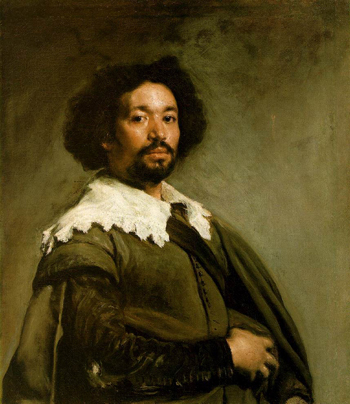
Juan de Pareja

|
Juan de Pareja
The remarkable and intriguing painting titled ‘Juan de Pareja’ was created by Diego Velázquez in approximately 1650, whilst on a stay in Rome. It is a portrait of Diego’s Moorish slave and workshop assistant, who accompanied his master during his second trip to Italy. It is believed that Velázquez decided to paint his assistant in preparation for creating the official portrait of Pope Innocent X.
Although the pope would be wearing the vibrant pink and red robes that matched the color scheme in his office, Velázquez choose a constrained palette for De Pareja’s portrait as the composition would have proven rather difficult to complete otherwise, considering the limited time frame.
In order to bring a particular “joie de vivre” to the image, Diego manipulated loose and broad brush strokes across the canvas. He skilfully managed to create the appearance of slightly worn out clothing, and to apply a lifelike stillness to the subject’s facial features – most notably in the eyes.
The Model
Above and beyond his duties as an assistant to Diego Velázquez, De Pareja was trained by his master to paint. He eventually became an adept painter, later producing works such as “The Calling of St. Matthew” (also referred to as The Vocation of St. Matthew). Velázquez freed De Pareja in November of 1650 and the certifying documentation still exists to this day.
The Artist
Born Diego Rodriguez de Silva y Velázquez in 1599, this artist began his studies in painting at a very early age. In 1611, at twelve years old, he enrolled in a five or six year apprenticeship with painter Francisco Pacheco. While Pacheco was not a famed artist, Velázquez learned important techniques and perspectives from him.
By 1620, Velázquez had established himself a reputable position in Seville. After marrying the daughter of his teacher, who bore his only two children, he became very active in producing art works.
In 1624, after painting King Philip V’s portrait in a single day, Diego Velázquez moved to Madrid because the pleased king offered him the position of court painter. With the king’s approval, Diego ventured twice to Italy, the first time in 1629, and again in 1649. Both trips would prove to be an integral part of his artistic career; not only did he further develop his techniques, but he explored paintings from various artists as well.
The First Exhibition
‘Juan de Pareja’ was displayed at the Pantheon in 1650 was bestowed an outstandingly positive reception. Antonio Palomino’s biography of Velázquez stated that, in regards to the viewers’ reaction, his piece “was generally applauded by all the painters from different countries, who said that the other pictures in the show were art but this one alone was 'truth'”. - Wikipedia
‘Juan de Pareja’ is currently located at The Metropolitan Museum of Art, in New York, USA.












